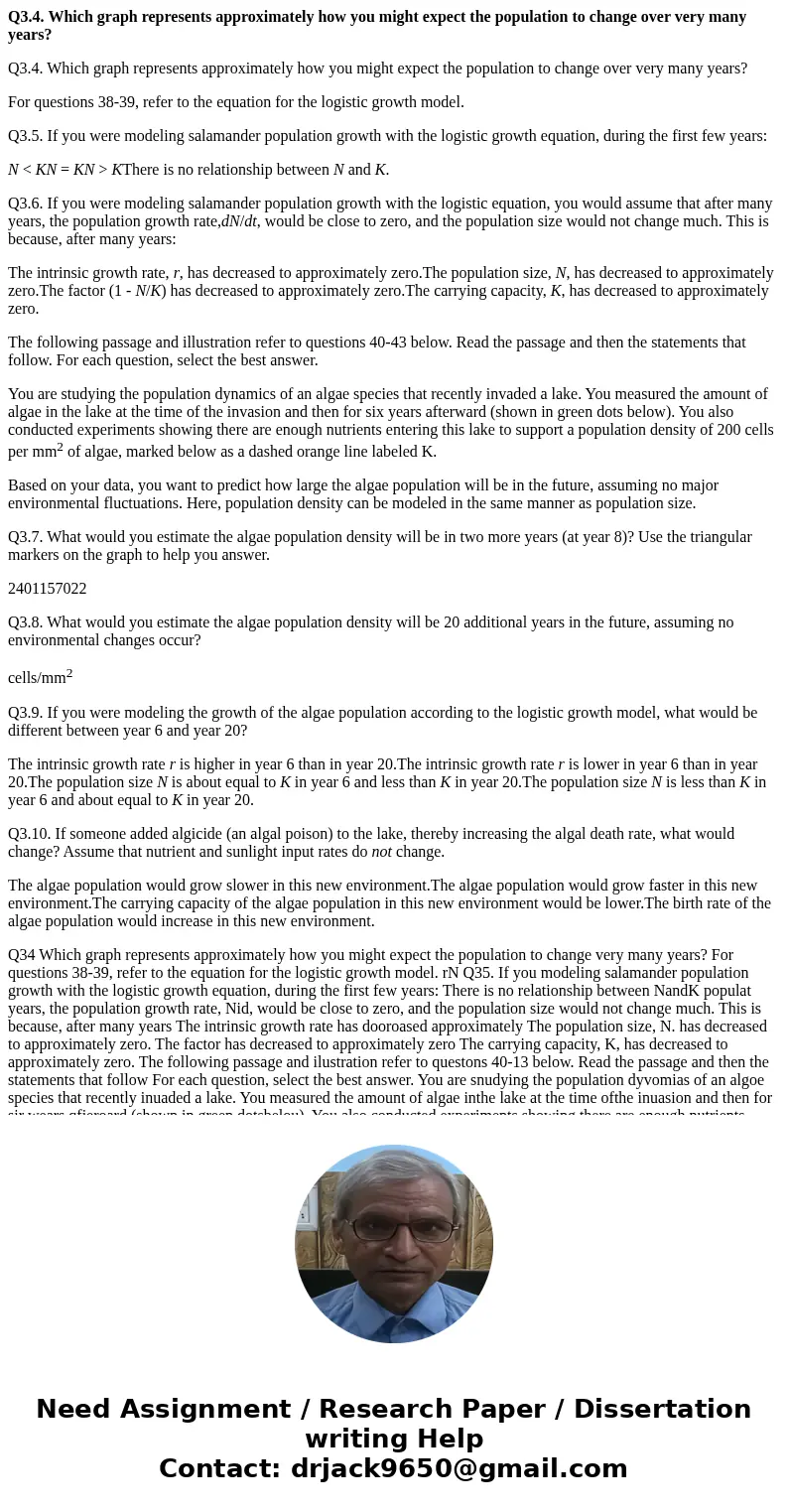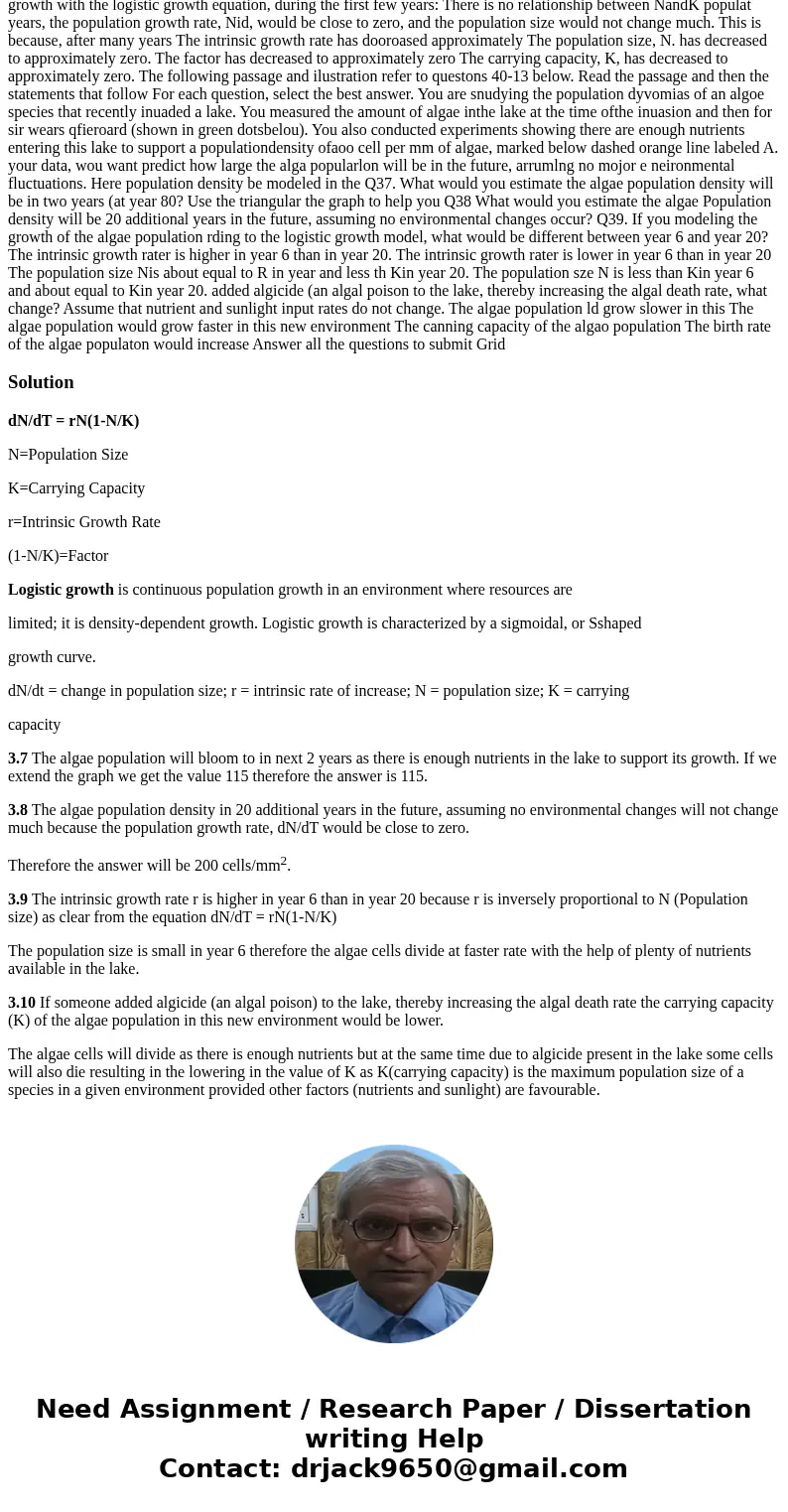Q34 Which graph represents approximately how you might expec
Q3.4. Which graph represents approximately how you might expect the population to change over very many years?
Q3.4. Which graph represents approximately how you might expect the population to change over very many years?
For questions 38-39, refer to the equation for the logistic growth model.
Q3.5. If you were modeling salamander population growth with the logistic growth equation, during the first few years:
N < KN = KN > KThere is no relationship between N and K.
Q3.6. If you were modeling salamander population growth with the logistic equation, you would assume that after many years, the population growth rate,dN/dt, would be close to zero, and the population size would not change much. This is because, after many years:
The intrinsic growth rate, r, has decreased to approximately zero.The population size, N, has decreased to approximately zero.The factor (1 - N/K) has decreased to approximately zero.The carrying capacity, K, has decreased to approximately zero.
The following passage and illustration refer to questions 40-43 below. Read the passage and then the statements that follow. For each question, select the best answer.
You are studying the population dynamics of an algae species that recently invaded a lake. You measured the amount of algae in the lake at the time of the invasion and then for six years afterward (shown in green dots below). You also conducted experiments showing there are enough nutrients entering this lake to support a population density of 200 cells per mm2 of algae, marked below as a dashed orange line labeled K.
Based on your data, you want to predict how large the algae population will be in the future, assuming no major environmental fluctuations. Here, population density can be modeled in the same manner as population size.
Q3.7. What would you estimate the algae population density will be in two more years (at year 8)? Use the triangular markers on the graph to help you answer.
2401157022
Q3.8. What would you estimate the algae population density will be 20 additional years in the future, assuming no environmental changes occur?
cells/mm2
Q3.9. If you were modeling the growth of the algae population according to the logistic growth model, what would be different between year 6 and year 20?
The intrinsic growth rate r is higher in year 6 than in year 20.The intrinsic growth rate r is lower in year 6 than in year 20.The population size N is about equal to K in year 6 and less than K in year 20.The population size N is less than K in year 6 and about equal to K in year 20.
Q3.10. If someone added algicide (an algal poison) to the lake, thereby increasing the algal death rate, what would change? Assume that nutrient and sunlight input rates do not change.
The algae population would grow slower in this new environment.The algae population would grow faster in this new environment.The carrying capacity of the algae population in this new environment would be lower.The birth rate of the algae population would increase in this new environment.
Q34 Which graph represents approximately how you might expect the population to change very many years? For questions 38-39, refer to the equation for the logistic growth model. rN Q35. If you modeling salamander population growth with the logistic growth equation, during the first few years: There is no relationship between NandK populat years, the population growth rate, Nid, would be close to zero, and the population size would not change much. This is because, after many years The intrinsic growth rate has dooroased approximately The population size, N. has decreased to approximately zero. The factor has decreased to approximately zero The carrying capacity, K, has decreased to approximately zero. The following passage and ilustration refer to questons 40-13 below. Read the passage and then the statements that follow For each question, select the best answer. You are snudying the population dyvomias of an algoe species that recently inuaded a lake. You measured the amount of algae inthe lake at the time ofthe inuasion and then for sir wears qfieroard (shown in green dotsbelou). You also conducted experiments showing there are enough nutrients entering this lake to support a populationdensity ofaoo cell per mm of algae, marked below dashed orange line labeled A. your data, wou want predict how large the alga popularlon will be in the future, arrumlng no mojor e neironmental fluctuations. Here population density be modeled in the Q37. What would you estimate the algae population density will be in two years (at year 80? Use the triangular the graph to help you Q38 What would you estimate the algae Population density will be 20 additional years in the future, assuming no environmental changes occur? Q39. If you modeling the growth of the algae population rding to the logistic growth model, what would be different between year 6 and year 20? The intrinsic growth rater is higher in year 6 than in year 20. The intrinsic growth rater is lower in year 6 than in year 20 The population size Nis about equal to R in year and less th Kin year 20. The population sze N is less than Kin year 6 and about equal to Kin year 20. added algicide (an algal poison to the lake, thereby increasing the algal death rate, what change? Assume that nutrient and sunlight input rates do not change. The algae population ld grow slower in this The algae population would grow faster in this new environment The canning capacity of the algao population The birth rate of the algae populaton would increase Answer all the questions to submit GridSolution
dN/dT = rN(1-N/K)
N=Population Size
K=Carrying Capacity
r=Intrinsic Growth Rate
(1-N/K)=Factor
Logistic growth is continuous population growth in an environment where resources are
limited; it is density-dependent growth. Logistic growth is characterized by a sigmoidal, or Sshaped
growth curve.
dN/dt = change in population size; r = intrinsic rate of increase; N = population size; K = carrying
capacity
3.7 The algae population will bloom to in next 2 years as there is enough nutrients in the lake to support its growth. If we extend the graph we get the value 115 therefore the answer is 115.
3.8 The algae population density in 20 additional years in the future, assuming no environmental changes will not change much because the population growth rate, dN/dT would be close to zero.
Therefore the answer will be 200 cells/mm2.
3.9 The intrinsic growth rate r is higher in year 6 than in year 20 because r is inversely proportional to N (Population size) as clear from the equation dN/dT = rN(1-N/K)
The population size is small in year 6 therefore the algae cells divide at faster rate with the help of plenty of nutrients available in the lake.
3.10 If someone added algicide (an algal poison) to the lake, thereby increasing the algal death rate the carrying capacity (K) of the algae population in this new environment would be lower.
The algae cells will divide as there is enough nutrients but at the same time due to algicide present in the lake some cells will also die resulting in the lowering in the value of K as K(carrying capacity) is the maximum population size of a species in a given environment provided other factors (nutrients and sunlight) are favourable.


 Homework Sourse
Homework Sourse